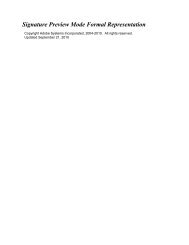010815as1
You also want an ePaper? Increase the reach of your titles
YUMPU automatically turns print PDFs into web optimized ePapers that Google loves.
Insurance Act of 1968. 561 The NFIP, as implemented, is not an actuarially sound program. This is<br />
because the amount FEMA collects in premiums fails to cover the full risk exposure of the<br />
program. Over its history, the program has experienced years in which the amount generated by<br />
policy premiums was sufficient to cover claims. But the damages caused by Hurricanes Katrina<br />
and Rita in 2005 far exceeded program funding, meaning that FEMA had to borrow additional<br />
funding from the Treasury in order to cover losses. 562 The $16.3 billion in damage claims caused<br />
by Hurricane Katrina in the Gulf Coast region was more than all of the previous NFIP claims<br />
from significant flood events combined. 563 As of November 2012, FEMA owed the Treasury $20<br />
billion, and had not repaid any principal on its loans since 2012. 564<br />
One of the reasons that the National Flood Insurance Programs is unsound and unable to<br />
cover its costs is the program’s heavily subsidized premium rates. Under the program, there are<br />
two classes of premium rates, full-risk or actuarial rates, and subsidized rates. Actuarial rates<br />
are based on consideration of the risk involved and accepted actuarial principles. 565 Subsidized<br />
rates are set at a level that “would be reasonable, would encourage prospective insured to<br />
purchase flood insurance and would be consistent with the purposes of the legislation.” 566<br />
According to FEMA, about 22 percent of all NFIP policies are covered by subsidized rates. 567<br />
These subsidized policy holders were grandfathered in to the program, despite the significant<br />
potential for economic lost and burden for the federal government in the event of a lowprobability<br />
but devastating flood. The rationale for allowing subsidized premiums was to<br />
permit structures that were built in these high-risk areas prior to the general implementation of<br />
the program, and subsequent flood-related building codes, to be covered by flood insurance at<br />
reasonable rates. At the same time, properties that experience repetitive flood losses, known as<br />
“severe repetitive loss properties,” account for a disproportionately large percentage of flood<br />
insurance claims, meaning that FEMA, and federal taxpayers, are paying out claims on the same<br />
561 Congressional Research Service, “The National Flood Insurance Program: Status and Remaining Issues for<br />
Congress,” R42850, February 6, 2013.<br />
562 U.S. Government Accountability Office, “High-Risk Series: An Update,” GAO-13-283, Washington D.C.<br />
February 2013, pg.261, available at http://www.gao.gov/assets/660/652133.pdf<br />
563 Congressional Research Service, “The National Flood Insurance Program: Status and Remaining Issues for<br />
Congress,” R42850, February 6, 2013, pg.6.<br />
564 U.S. Government Accountability Office, “High-Risk Series: An Update,” GAO-13-283, Washington D.C.<br />
February 2013, pg.261, available at http://www.gao.gov/assets/660/652133.pdf<br />
565 42 U.S. Code § 2014 (a) (1).<br />
566 42 U.S. Code § 2014 (a) (2).<br />
567 Congressional Research Service, “The National Flood Insurance Program: Status and Remaining Issues for<br />
Congress,” R42850, February 6, 2013, pg. 19.<br />
119


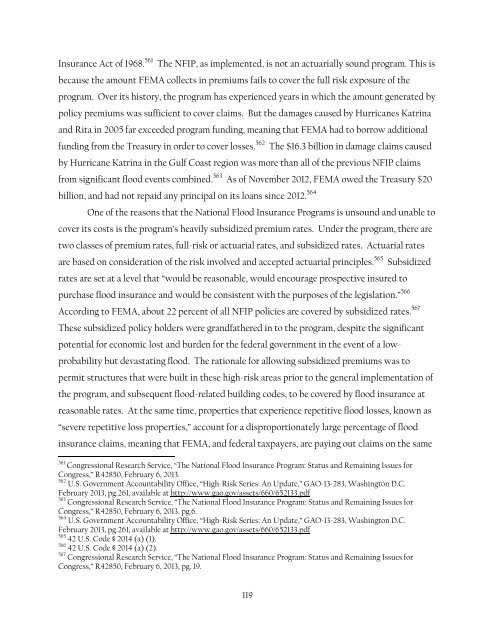


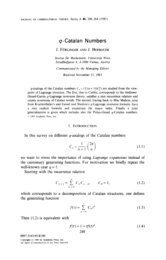
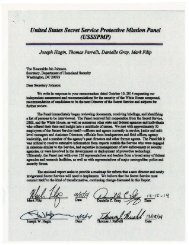
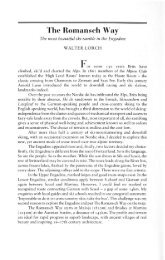
![55721335-d6fe09eb5ffdcc87dbf6c3f0b5bbda07d2261e98[1]](https://img.yumpu.com/56533583/1/186x260/55721335-d6fe09eb5ffdcc87dbf6c3f0b5bbda07d2261e981.jpg?quality=85)




